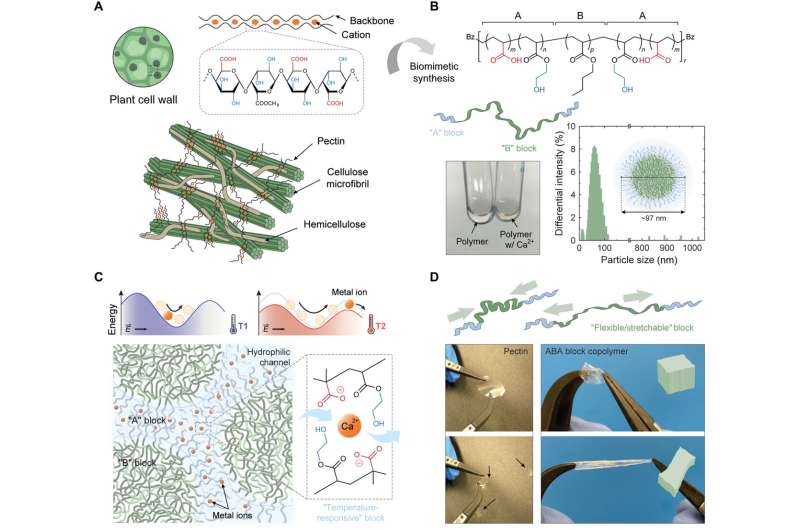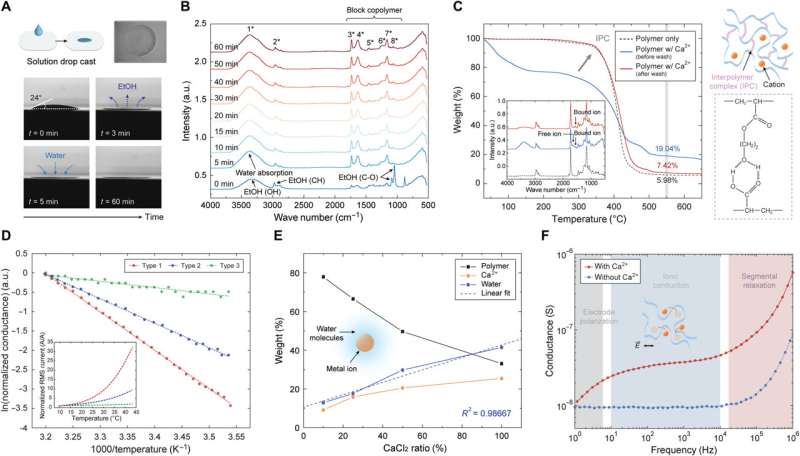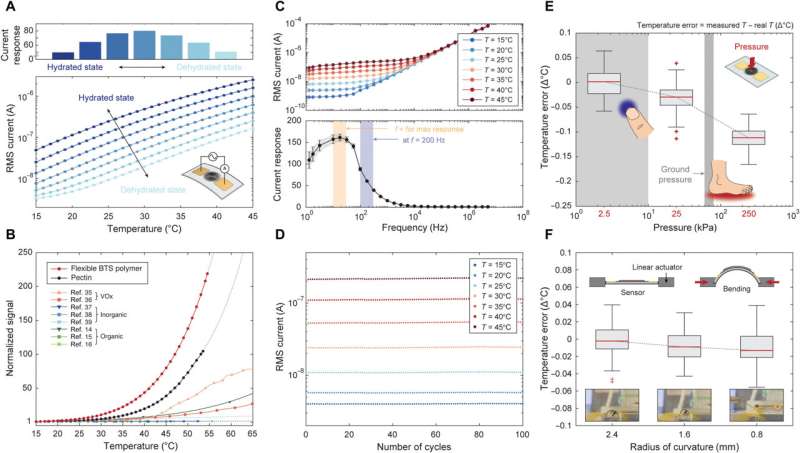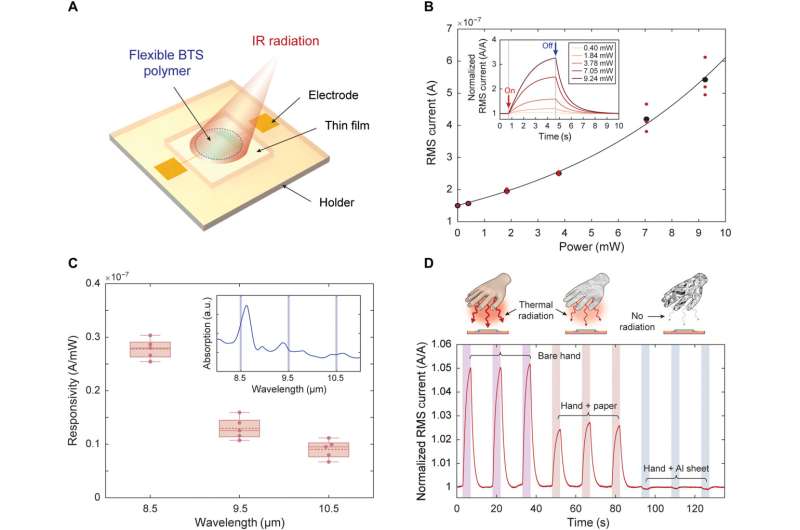Biomimetic design of the flexible BTS polymer. (A) Schematic illustration of the plant cell wall structure and of pectin. (B) Design of the ABA-type block copolymer, with m = 5, n = 5, p = 100, and r = 85.7. The hydrophilic A block, rich in carboxyl (red) and hydroxyl (blue) groups, is designed to electrostatically interact with metallic cations. The hydrophobic B block, composed of poly(n-butyl acrylate), is designed to provide mechanical flexibility and stretchability to the network. As shown in the particle size measurement (bottom right), the synthesized polymer exists in a colloidal state in ethanol due to phase separation. (C) Hypothesized mechanism governing the temperature response of the synthetic block copolymer. Rearrangement of the potential wells at low and high temperature in which the cations are confined (top). When an external electric field is applied, temperature rises cause an increase in ion migration through the hydrophilic channels formed between the colloidal particles in the polymer matrix (bottom). (D) Mechanical flexibility and stretchability of the synthetic block copolymer. The dried pectin film is prone to tear after a slight bending deformation (left), whereas the composite polymer is robust to repeated stretching motions because of the soft B block (right). The polymer is stretched 300% from its original shape. Credit: Science Advances (2023). https://www.science.org/doi/10.1126/sciadv.ade0423
Materials scientists are often inspired by nature and therefore use biological compounds as cues to design advanced materials. It is possible to mimic the molecular structure and functional motifs in artificial materials to offer a blueprint for a variety of functions. In a new report in Science Advances, Tae Hyun Kim and a research team at the California Institute of Technology and the Samsung Advanced Institute of Technology in the U.S. and South Korea, created a flexible biomimetic thermal sensing polymer, abbreviated BTS, which they designed to mimic ion transport dynamics of pectin; a plant cell wall component.
The researchers used a versatile synthetic procedure and engineered the properties of the polymer to be elastic, flexible and stretchable in nature. The flexible polymer outperformed state-of-the-art temperature sensing materials such as vanadium oxide. Despite mechanical deformations, the thermal sensor-integrated material showed high sensitivity and stable functionality between 15° and 55° Celsius. The properties of the flexible BTS polymer made it well suited to map temperature variations across space-time and facilitate broadband infrared photodetection relevant for a variety of applications.
All-organic electronic materials developed with pectin
Organic electronic materials are competitive alternatives to conventional silicon-based microelectronics due to their cost-effective, multifunctional nature. Materials scientists seek to tailor the properties of such materials at the molecular level for a range of sensing applications for wearable and implantable devices with specific characteristics such as flexibility and elasticity. At present, there is an increasing demand for all-organic electronic devices to form a range of soft and active materials. For instance, organic thermal sensors are suited for remote health care and robotics, albeit with limitations.
Researchers have therefore sought to develop organic materials with a high thermal response and flexibility using a relatively simple scaffold through recent studies of pectin; a plant cell wall component made of a structurally and functionally complex polysaccharide. Since devices developed with pectin as a sensing element are structurally unstable, Kim and colleagues introduced a new, flexible biomimetic thermal sensing (BTS) polymer, bioinspired by the structural and functional motifs of pectin. The researchers used a versatile, living radical polymerization method to engineer the structures with inherent mechanical stability and flexibility, suited for organic electronic materials.
Film formation behavior and component analysis of the block copolymer. (A) Digital images of the cross-linked block copolymer solution drop-casted on a flexible plastic substrate. The amount of cross-linking metal ions used for all tests is fixed to 100% unless otherwise stated. a.u., arbitrary units; EtOH, ethanol. (B) Time series of ATR-FTIR spectra after polymer deposition. During 1 hour of air dry, ethanol starts to evaporate, and subsequently, water is absorbed and saturated by the hygroscopic regions in the polymer matrix. *Peak assignments of the ATR-FTIR spectra (table S4). (C) TGA profile of the polymer film before and after washing in DI water. Titration analysis is performed to determine the percent of IPC formed in the composite film based on the amount of bounded metal ions after wash. Inset: Corresponding FTIR spectra of the films. (D) Arrhenius plot of different block copolymers. Activation energy compared between different polymer films with varying ratio of carboxyl to hydroxyl functional groups (type 1: m = 5, n = 5, p = 100; type 2: m = 4, n = 7, p = 100; type 3: m = 10, n = 0, p = 100). Inset: Corresponding thermal response of each type of polymer compared. Measurements are performed using the electrode design fabricated in fig. S6B with an AC voltage bias of 300 mV at 200 Hz. (E) Relation between the concentration of metal ions in the composite film and the amount of water adsorbed. Weight percentage of the polymer, Ca2+, and water is calculated on the basis of the TGA profile and the coupled gas-phase FTIR spectra of the dried polymer films (fig. S5) with varying amount of CaCl2 (table S5). A linear relationship is observed between the CaCl2 concentration and water absorbed by the composite film. (F) Impedance spectra of the polymer film with and without Ca2+. Credit: Science Advances (2023). https://www.science.org/doi/10.1126/sciadv.ade0423
Designing flexible BTS (biomimetic thermal sensing) polymers
The scientists created the polymer architecture by reducing the complex pectin structure to a simpler backbone with an egg-box complex and added mechanical stability to the polymer. The team verified the structural components of the block copolymer by using gel permeation chromatography and nuclear magnetic resonance measurements. The team added divalent calcium ions into the flexible BTS polymer solution to reveal a network of ionic crosslinks.
They monitored the process with attenuated total reflectance-Fourier transform infrared spectroscopy to understand the behavior of film formation, where the characteristic peaks indicated the structures of the designed polymer. They varied the concentration of ions to further investigate the film's functionality.
Characterization of the flexible BTS polymer sensor. (A) Current variation as a function of temperature, measured between 15° and 45°C with an applied voltage of 300 mV at 200 Hz (bottom) and the corresponding current response calculated at different hydration levels (top). Darker blue lines represent higher hydration, and lighter blue lines represent lower hydration. Inset: Device schematic and configuration for electrical measurement. (B) Response comparison between state-of-the-art temperature sensing materials and devices, normalized with signals at 15°C. (C) Frequency-dependent current measured between 1 Hz and 5 MHz at varying temperatures (top) and the corresponding current response calculated when 300 mV was applied (bottom). Maximum response of 161.3 is obtained at 17.8 Hz. (D) Cyclic stability test over 100 cycles of continuous temperature oscillation between 15° and 45°C. (E) Temperature error extracted from the thermal sensor as a function of normal pressure and (F) bending strain (curvature). All plots represent data from polymer solution cross-linked with 100% concentration of CaCl2. Credit: Science Advances (2023). https://www.science.org/doi/10.1126/sciadv.ade0423
Temperature mapping and broadband long-wave Infrared (IR) sensing applications
The research team next studied the potential of the flexible BTS polymer composite for temperature mapping and for long-wave infrared photodetection. They accomplished this by first creating a flexible temperature sensing sheet engineered with uniformly spaced sensors. They observed a high temperature response, alongside flexibility, to offer opportunities for a variety of industrial applications, such as batteries, perishable items and wearable thermometers that require three-dimensional surfaces.
The team also developed an uncooled long-wave IR-sensor to detect thermal radiation across a wide spectral range. To accomplish this, they reduced thermal loss via heat conduction and engineered the electrodes on a thin polyimide membrane. The researchers further investigated the spectral responsivity of the sensor and detected IR-emitting objects at room temperature.
-
Temperature sensing array based on flexible BTS polymer. (A) Schematic diagram of a flexible thermal sensor for large-area, multipixel temperature mapping. The sensor is placed on top of a glass plate where a heat source in the middle is used to generate a thermal gradient across the surface. Inset: Time versus temperature profile of the heat source (top) and the measured temperature value from each sensor (bottom). (B) Spatiotemporal reconstruction of the temperature evolution across the glass plate. Data are extracted from five sensor pixels along the radius of the glass slide. Credit: Science Advances (2023). https://www.science.org/doi/10.1126/sciadv.ade0423
-
IR sensor based on flexible BTS polymer. (A) Schematic of the fabricated long-wave, thermal IR detector. (B) Current as a function of IR power irradiated at a wavelength of 8.5 μm. Inset: Representative current profile during a 4-s period of IR exposure in air with different power. Current is measured using an applied voltage of 1 V at 200 Hz. (C) Responsivity of the IR detector at different wavelengths. Inset: Wavelength-dependent absorption intensity of the block copolymer. (D) Real-time detection of thermal radiation generated by a hand wave motion. Covering the hand with a sheet of paper, the rise in current is reduced due to limited transmission of irradiation power. Covering the hand with an aluminum sheet, no change or decrease in current is observed due to IR reflection. Credit: Science Advances (2023). https://www.science.org/doi/10.1126/sciadv.ade0423
Outlook
In this way, Tae Hyun Kim and colleagues presented a biomimetic approach to design a thermally responsive polymer for organic electronics. The functional motifs of the material allowed the development of a block copolymer with an external high thermal response and low sensing resolution. These sensors can be incorporated in medical and health care instruments to non-invasively monitor precise pathophysiological stresses, which include homeostasis, infection and inflammation.
The outcomes of this study will lead to further improvements of the technical instruments, and the development of all-organic electronic devices with improved functionalities, beyond their inorganic counterparts.
More information: Tae Hyun Kim et al, Flexible biomimetic block copolymer composite for temperature and long-wave infrared sensing, Science Advances (2023). DOI: 10.1126/sciadv.ade0423. www.science.org/doi/10.1126/sciadv.ade0423
Sihong Wang et al, Skin electronics from scalable fabrication of an intrinsically stretchable transistor array, Nature (2018). DOI: 10.1038/nature2549
Journal information: Science Advances , Nature
© 2023 Science X Network




























